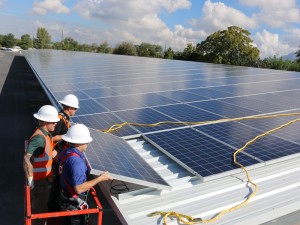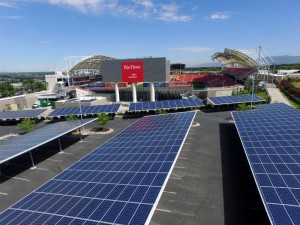- Products
- Industries
- Project Gallery
- Resource Center
- Metal Institute
- Services
- Shop
- Contact Us
March 23, 2016
by Candy McNamee
Everyone is talking about—and doing something about—sustainability. Metal roofs fit nicely into the sustainable-material equation because of their myriad traits, such as recyclability, reflectivity, longevity and durability. Another major component in the sustainability equation is renewable energy—the production of energy from renewable resources like sun and wind. A metal roof is the ideal location for solar energy production on homes, commercial buildings and recreational applications.

One of the key factors for long-term success of rooftop solar energy is the quality of roof under the solar panels. Roofs under photovoltaic (PV) systems should be durable and have an equivalent service life to the solar panels. However, too many traditional roof systems do not have a service life that matches, let alone exceeds, the service life of the PV panels. This is where metal roofs excel.
A study of roof system longevity presented at the Fourth International Symposium on Roofing Technology by Carl Cash, a principle at Simpson Gumpertz & Heger, showed that metal panel roofs have the longest service life when compared to asphalt-based roofs and single ply roofs. The study showed that the average life of metal panels is 25 years. BUR and EPDM were second and third, respectively, at 16.6 and 14.1 years of average service life. Exceeding the Cash study, a more recent study conducted by the Metal Construction Association (MCA) and Zinc Aluminum Coaters (ZAC) Association showed the longevity of low-slope unpainted 55% Al-Zn alloy coated steel standing seam roofing (SSR) systems is 60 years.
Solar panels will last 25 to 30 years. In fact, some of the very first PV panels from the 1960s and 1970s are still producing energy. While their efficiency might decrease over time, solar panels will make electricity for many decades. For the most cost-effective rooftop solar energy installation, the longevity of the roof should be equivalent, or greater, than the solar panels so that the roof doesn’t need replacement during the life of the solar energy system. Metal panels are the most reliable, long-term roofing system for solar energy installation projects.

Simply put, installing solar energy on rooftops that don’t have an equivalent service life is a mistake, especially for solar projects that cover a large portion of the rooftop. The cost of decommissioning, removing, and replacing rooftop solar energy can cost 20% to 100% of the original installed cost. The cost tends to align with the percentage of rooftop covered with solar panels. Much of the cost to remove and reinstall is labor, but an older solar energy system will likely need some new components—most likely new wiring—when reinstalled, also adding to the cost.
Rooftop solar installations continue to grow year over year. And with the extension of the federal investment tax credit for five years, expect more solar energy installations on roofs. Pair solar energy with a metal roof, and you’ve hit a sustainable “home run.”
Learn other ways to implement Net-Zero Energy strategies into your building and learn how MBCI’s products contribute.